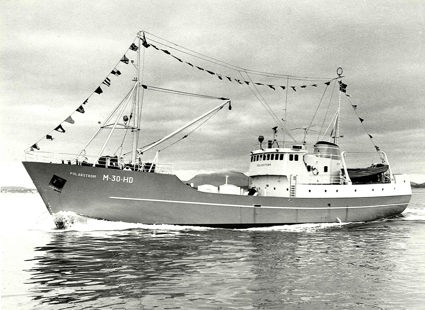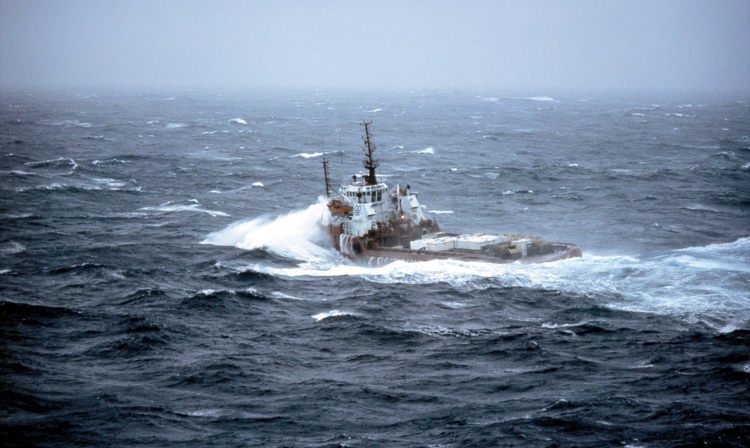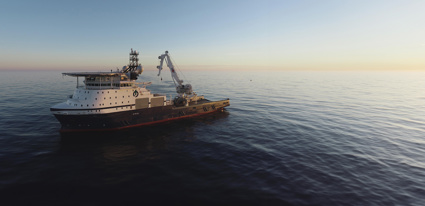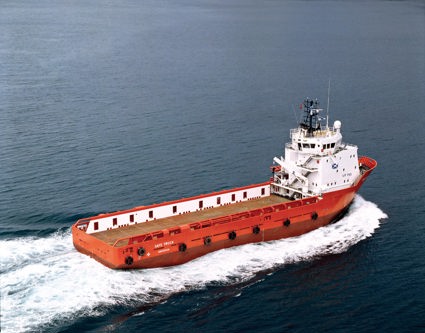
The iconic UT-Design vessels trace their origins back to the mid-1960s and the Norwegian fishing industry, and early 1970s for the international offshore industry. Years of expertise in operating ships in the harsh conditions of the North Sea paved the way for what would become the benchmark design for the offshore industry.
-
Text:Global Sales and Marketing
Photo:© Kongsberg Maritime | © Island Offshore
-
Craig TaylorSenior Manager PR & Communications
Kongsberg Maritime’s ship design history goes back 50 years with its origins in the heart of what is today’s maritime cluster on the west coast of Norway.
Today, the company offers some of the most advanced vessel designs available, across a wide rangeeloped for the offshore, fisheries and merchant markets, but since then the portfolio has expanded significantly. of market segments to customers across the world. From the early 1970s, ship designs were developed for the offshore, fisheries and merchant markets, but since then the portfolio has expanded significantly.
The UT-Design, which takes its name from the company where it all began, Ulstein Trading, is a benchmark for offshore vessels, with the early designs setting the standard for the latest vessels we see today, with more than 800 UTs built to date.

Another Norwegian company, Nordvestconsult, which also started in the early 1970s was designing cargo and fishing vessels, and later moved on to larger RoRo ships. Today, Kongsberg Maritime’s designs for merchant, passenger, fisheries and some special purpose ships have the NVC prefix in their model numbers.
Between UT and NVC designs, Kongsberg Maritime has designed more than 1,000 ships. Jørn Heltne, Vice President – Sales, in the Ship Design team, and Per Egil Vedlog, Chief Designer, recount the fascinating story.

Origins in fishing
The very first UT designed vessel, wasn’t an offshore vessel at all, but an elegant Purse seiner fishing vessel. The M/V Polarstrøm was delivered from Ulstein Verft to Bjørn Øvrelid in Hjørungavåg in 1966 and is technically number one in the UT reference list.
At the dawn of North Sea offshore oil and gas in the early 1970s, the choice of offshore vessel was limited, with the only options being simple service vessels used in the relatively shallow waters of the Gulf of Mexico. They were soon found to be lacking in capability, particularly enough freeboard, and seakeeping.
The solution to these early challenges came from a small shipyard group on the west coast of Norway. Ulstein Trading (UT), formally set up in 1967 as the sales and ship design company within the Ulstein Group, set about designing what would become the vessel of choice for the offshore industry.
The team at UT began a study of the requirements for this new class of ship. They looked at specific requirements for the emerging oil and gas operations between Norway and Scotland. They also looked at service vessels then available and, importantly, consulted with Norwegian fishing fleet owners, who had vast experience of working in the North Sea.
The specification centred around three key elements: good sea keeping, a large freeboard and cargo capacity, and a design that came in under the 500GRT tonnage rule.
In 1974, the first UT offshore supply vessel, a platform supply vessel (PSV) labled UT 705, went into service, along with the first UT 704 anchor handling tug supply vessel (AHTS). The impact was immediate. In the past, oil companies had issued long and complex specifications, but from now it was the UT 704 that defined the specification. The UT 704 and UT 705 soon established the UT reputation around the world, with 91 and 31 of each design, respectively, built.
Developments in efficient propulsion have been rolled out on many UT vessels over the years. The UT 709 Wildrake, a diving vessel delivered to Norwegian owner Anders Wilhelmsen was the first to feature diesel-electric driven CPP azimuthing thrusters, while the UT 705 Stad Ulstein, pioneered the use of a swing-up thruster in the bow.
Following initial success, the UT evolved through two approaches to supporting the growing offshore market. First, the Ulstein design team would evaluate the market and develop general designs to meet demand. For example, almost standardised designs for the PSV market with the UT 745 and the smaller UT 755, which would go on to be the most popular UT design, with 179 vessels built.
Another high-volume design is the UT 722 AHTS, which is still attracting interest today. This proven, robust design was recently selected for a pair of powerful tugs currently in build for the Suez Canal Authority.
The other approach was a more bespoke and collaborative one, where the team would work with individual ship owners, developing ship designs suited to their specific needs, in order to meet the demanding requirements of the contracts let by oil companies.

UT 704 – an offshore pioneer
The first UT-Design ship for the emerging North Sea offshore market was the UT 704 Stad Scotsman. This pioneering ship is still in service today, having gone through many changes of ownership and names – it became the Red Condor, then Seabulk Condor, and today the Reliance Star 1.
Big change on the horizon
The late 1990s would see major change for Ulstein Trading, and it would impact the future development of the UT-Design. In 1997, the family-owned Ulstein Group was listed on the Oslo Stock Exchange. Two years later the equipment and ship design parts of the group, but not the shipyard, were acquired by Vickers plc. Within a few months the expertise in ship design, together with an expanding range of ship equipment, would again change hands, as fellow UK engineering company Rolls-Royce acquired Vickers.

Balder Torungen is a successful ship design that dates from the 1970s
The late 1990s would see major change for Ulstein Trading, and it would impact the future development of the UT-Design. In 1997, the family-owned Ulstein Group was listed on the Oslo Stock Exchange. Two years later the equipment and ship design parts of the group, but not the shipyard, were acquired by Vickers plc. Within a few months the expertise in ship design, together with an expanding range of ship equipment, would again change hands, as fellow UK engineering company Rolls-Royce acquired Vickers.
By the time Kongsberg Maritime acquired the Commercial Marine division of Rolls-Royce, two decades later in 2019, more than 800 UT-Design vessels had been delivered, with many ground-breaking technologies debuting as the design portfolio expanded.

Record-breaker
Delivered in 2020, Island Offshore’s special purpose UT 797 CX Island Victory holds the world record for bollard pull – an impressive 477 tonnes. It features a comprehensive range of Kongsberg Maritime technology, performing heavy anchor handling operations and deep subsea installation work. Senior Ship Designer Stig Ole Borgundvåg played a leading role in this project. He says: “Island Victory is a special ship. It incorporates market leading pulling power, along with impressive crane capacity and it’s adaptable for critical offshore duties. It was a challenge to design, and my father worked on this project up until his retirement, then I took over, so it has a special personal connection, too. It’s in very high demand, attracting high day rates. A vessel like this is the perfect example of Kongsberg Maritime’s competency as a world-leading ship designer in the global offshore market.”
Image: © Island Offshore
Extensive design portfolio
Over the last 25 years, the UT-Design continued to develop, often first to market with new technological enhancements. The PSV and AHTS market remained the core business for the design team, but other markets were developing.
Subsea construction was one area where the UT would become established. These vessels would be equipped with offshore cranes and other equipment to enable them to accurately position heavy modules on the seabed. A new series of vessels with a crane capacity ranging from 150 to 600 tonnes was launched.
In 2004, one of the most advanced UT vessels was delivered to owner Island Offshore. The UT 737 CD, Island Frontier, was a ground breaker followed by the UT 767 CD in 2008. These vessels were a pair of Riserless Light Well Intervention units, and proved that cost effective and safe well intervention could be carried out from a mono hull vessel platform just as effectively as from rigs.
Over the years, the UT has not only kept pace with technology, but led the way, and one thing has remained a priority in all designs – safety. A range of Safer Deck Operations equipment was developed, that reduces the exposure of the deck crew when handling wires and chains and eliminates much heavy manual work, a feature that is common on today’s ships.
The UT-Design has been deployed into other specialist roles. They have included seismic survey vessels and offshore vessels with icebreaking hulls. Ocean-going tugs, capable of a range of critical duties are in service with several coast guards and navies, and among their key duties are, deep-sea towing, firefighting and anti-pollution duties.
Oceanographic research ships are some of the most technologically advanced to date. Built with polar ice class capabilities, they are crammed with high-tech equipment and have strict operational requirements.
Today, the UT-Design is moving in a new direction, but one that’s true to its roots in the offshore industry. As the world shifts towards greener technologies, the UT offers advanced solutions for the rapidly developing offshore wind market, and with tougher environmental regulations ship owners are demanding green solutions. The UT has continued to evolve and is equally suited to the workhorse routine duties, or the more complex missions we see today. The years to come will see more exciting developments, with alternative fuels, more digitalisation and electrification becoming the norm. One thing is certain, in the world of ship designs, the UT, never stands still.

UT 755 – the most popular
The UT 705 supply vessel design had helped to establish the UT-Design reputation, but the need for a smaller PSV workhorse was identified and the UT 755 was born. First developed in the 1990s, the UT 755 became the most popular design, with 179 delivered. A true workhorse of the offshore industry, it was initially introduced in short (67-metre) form. Later, longer (UT 755 L) versions followed, and its Kongsberg Maritime propulsion system, including CPPs, tunnel thrusters at each end and a swing-up azimuth thruster under the bow, gave the UT 755 economic operation and excellent manoeuvrability and position-keeping.
Einar Vegsund, Vice President - Ship Design
Visit our website
Decarbonisation by design.


